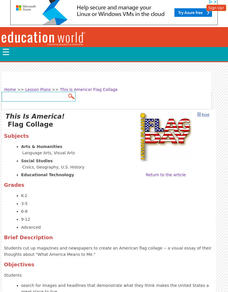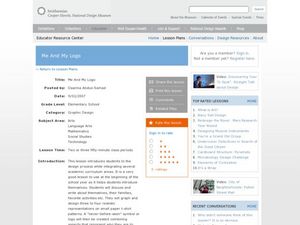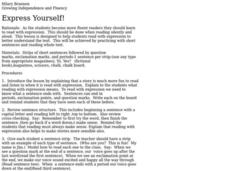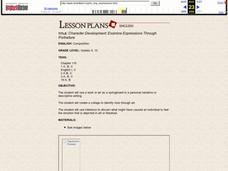Curated OER
Red Circle, Red Circle, What Do You See?
Young learners explore shapes and colors. They listen to Brown Bear, Brown Bear What Do You See? by Bill Martin Jr. and use the same language pattern to create a color and shape book of their own. After that, with the leftover magazine...
Curated OER
Majestic Murals
Albert Bierstadt is a highly celebrated artist who was able to capture the beauty of the American landscape. The class will first learn how Bierstadt explored America during the 1800s and painted the majestic countryside. Then, they will...
Curated OER
This Is America! Flag Collage
In a visual essay of their thoughts about "What America Means to Me," kids of any age can create a collage about their country. Originally intended to be created physically, learners could share their projects online by using an...
Curated OER
Topical Discussions
Engaging in topical discussions can be a great way to teach kids how to build strong arguments and support their opinions with concrete evidence. High schoolers choose a controversial topic, build an argument for or against that topic,...
Curated OER
Fun With Chicka Chicka Boom Boom
Students read the book Chicka Chicka Boom Boom and listen to the musical tape. Then they make their own coconut trees, adding their own letters. They express and record their favorite parts. All are displayed on a bulletin board.
Curated OER
Two Sides, Same Coin: How Political Beliefs Influence Language Use
Learners read several magazine articles on the same topic written from different political perspectives, paying particular attention to the diction, syntax, and arguments presented in support the point of view expressed. They then select...
Curated OER
Storytelling Traditions
Students demonstrate an evaluation of how the culture of a time period influences storytelling narratives by comparing Adeline's story to the plot summary of Cinderella and Anne Sexton's poem Cinderella. They write a poem which reworks a...
Curated OER
Self-Portraits Inspired By Saint Helena
Students create their own self-portrait revealing personal information employing two types of aesthetics: imitation and expression. Emphasis is placed on the painting "Saint Helena with True Cross" created by Lucus Cranch the Elder.
Curated OER
Japanese Collage
Seventh graders compare and contrast different types of art associated with different cultures. They identify how cultures express their values in art. They create their own collage about Japan.
Curated OER
An Introduction to The Outsiders
Introduce S.E. Hinton’s The Outsiders with a bell work journal that asks class members to define loyalty. Key words (patience, unity, honesty, caring, etc.), drawn from their musings, are posted around the room, and groups search for...
Curated OER
Me and My Logo
Young scholars design their own emblem. In this introduction lesson, students get to know one another by designing an emblem that combines symbols that represent themselves. They express themselves to their classmates.
Curated OER
To Quote or Not to Quote
Introduce your middle and high schoolers to the correct use of quotation marks. They identify examples of correct and incorrect quotations in magazines and edit a paragraph in groups. Use this lesson as a way to reinforce proofreading...
Curated OER
Dream Kitchen
Advanced ESL students can engage in this lesson designed to practice compiling lists, adding costs, and describing why they chose a particular item. They will choose items from a magazine that they'd like in their dream kitchen. Next,...
Curated OER
Express Yourself
Students investigate the different types of sentences that are found in common usage including exclamatory, interrogative, declarative, and imperative. They examine samples of the different types of sentences and identify the name for each.
Curated OER
CHARACTER DEVELOPMENT: EXAMINE EXPRESSIONS THROUGH PORTRAITURE
Students use a work or art as a springboard to a personal narrative or descriptive writing, create a collage to identify tone through art, and use inference to discern what might have caused an individual to feel the emotion that is...
Curated OER
Expressive Linear Sculpture
Students develop skill in utilizing line in a 3 dimensional context. They explore a variety of techniques for mounting sculptures to a base.
Edutopia
Empathy
Teach your learners about support, respect, and listening skills with an activity about empathy. Class members set goals for themselves regarding their peer relationships, and monitor their own progress over a period of time.
Baylor College
Neurotransmitters Contain Chemicals
Human body systems students play a card game, "Locks & Keys" in order to learn that neurotransmitters carry a message from one neuron to another by fitting into a receptor site on the receiving nerve cell. While this activity can...
Curated OER
DONDE VIVES?
Students discuss the rooms of a house, using location expression. They work in groups as "extended families" and use magazine pictures to describe their relatives.
Curated OER
Media Analysis--Culture and Gender Roles
Ninth graders participate in class discussion about culture and how it influences our lives then complete an analysis of advertisements from popular magazines to derive what effects they have on our culture. They use analysis of adds to...
Curated OER
Rainforest Unit
Students investigate the Rainforest. In this Rainforest lesson, students research magazines, journals and the Internet to create a "Save the Rainforest" slogan. Students will record local rainfall amounts and create a graph comparing...
Curated OER
The Surreal World
Students explore the concept of Surrealism and how it can be expressed in various art forms. They next create a Surrealist collage, and engage in a Surrealist process to invent a title for their work. They critique a class exhibition of...
Curated OER
Goddesses Are Personifications Too!
Students explore the use of personification as a way of expressing ideals. They transfer this understanding to the present by creating an allegorical depiction of a contemporary ideal or value inspired by precedents in the...
Curated OER
1984
Young scholars read 1984, noting the potential dangers of government. They keep private diaries to parctice freedom of expression. They create political cartoons for a secret publication and design posters and T-shirts with warnings on...























